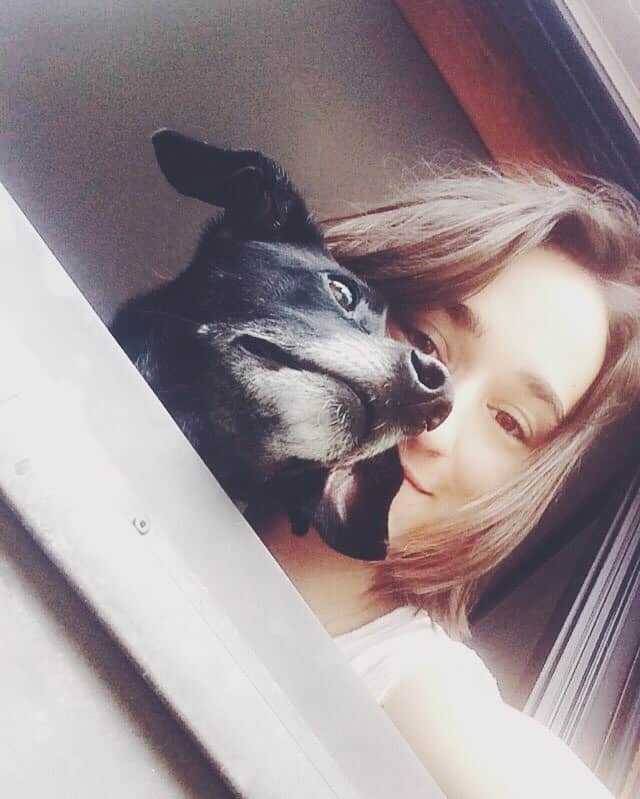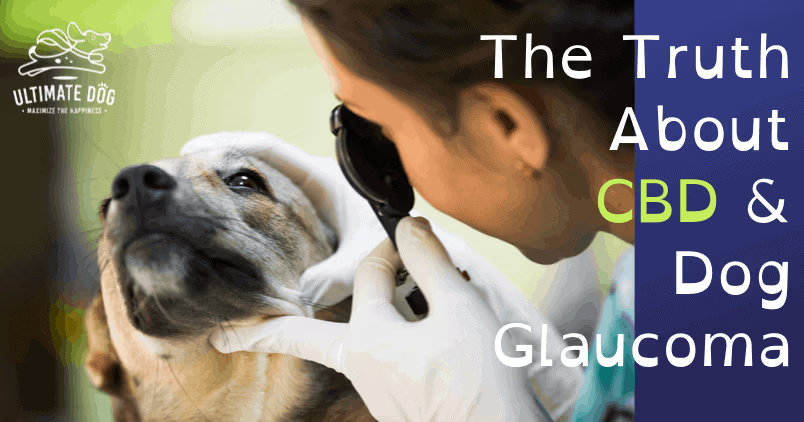Having to witness your loyal and loving furry companion in a state of pain is, without a doubt, the greatest distress any pet owner can imagine. We all strive to invest in our dog’s health from the moment we first hold them, but an illness can creep up silently. Before we fully have a chance to realize what is going on, the condition has heavily progressed and we’re faced with incredibly difficult decisions.
Glaucoma is one of such conditions. It has an immense fast speed of progression: 40% of dogs affected by glaucoma will become blind within months, many will have the eye removed. As many owners struggle to cope with managing this condition in their dogs and weigh their options of treatment and medication, alternative and holistic veterinary medicine advocates for CBD oil as a possible option in managing (even alleviating) the symptoms of this sensitive condition.
Before trying something new for their dog’s health, most people wish to do their own research first – google the topic and read up on the information. But here is where it gets tricky. When you search the web for information on how CBD affects glaucoma, you emerge from the search more confused than you initially went into it.
Many sources claim that CBD is absolutely the way to go, but just as many say it can make the condition worse. In this article, we’ll be looking at the details of how exactly CBD affects glaucoma, what the research says, and the truth you have to know before taking this leap of faith.
What is glaucoma and how does it affect dogs?
Glaucoma is a condition where the pressure in the eye gets very high, causing the dog a lot of pain, enlarging the eye, impairing the vision, and eventually leading to full blindness. In some cases, the affected eye has to be removed because of the severe pain it’s causing the dog. If glaucoma is identified in one of the eyes, there is a very high chance that the other eye will get affected as well, in a matter of mere months.
What causes dog glaucoma?
Glaucoma is caused by a blockage in the draining of the eye fluid called the aqueous humor. The amount and balance of this fluid are directly connected to intraocular pressure, also referred to as IOP. When there is a blockage, and the eye fluid cannot drain out while the cells continue producing it, the pressure in the eye increases.
There are two main reasons for this blockage. The first is genetics. For some dogs, glaucoma is an inherited condition connected to their breed. This is known as primary glaucoma. Some of the most affected breeds are found among the Spitz breeds (such as Siberian Husky, Elkhound, Samoyed, Chow Chow). Other breeds predisposed for glaucoma are Cocker Spaniel, Poodle, Shih Tzu, Basset Hound, and Jack Russel Terrier.
The second reason for the blockage can be a previously undiagnosed eye disease that affects the balance of the eye fluid and so increasing the IOP. This is known as secondary glaucoma.
What are the main symptoms?
It’s very important to be aware of the fact that, in most cases, by the time the owner notices any symptoms on the dog’s eyes, glaucoma will have progressed to the point where vision is already impaired, often beyond repair. Early detection of glaucoma is rare because the first (and most important) symptom is pain. Increased IOP causes the dog a lot of pain.
Unfortunately, dogs can’t tell us with words when they are hurting. In fact, they cope with the pain in a way that is opposite to ours. For example, when humans are experiencing pain, we rub and hold the area that hurts us. In contrast, dogs avoid touching the painful area altogether. The pain that is a result of a high IOP feels like a constant headache and dogs have a hard time communicating that. This is why pain is so hard to recognize in dogs – it’s far from obvious.
These are some subtle signs of head and eye pain:
- Refusing to be touched, especially on the head and around the eyes.
- Sudden changes in mood and behavior, such as irritability and snapping.
- Decreased energy and apathy, for example, refusing to go on a walk or not wanting to play.
- Decreased appetite.
- Shaking.
- Increased panting, even without any exercise.
- Changes in sleep patterns, such as not sleeping (pacing around) or sleeping too much.
The second symptom is vision impairment and blindness, but just like with pain, it’s hard to detect. Dogs are very adjustable – if they lose vision in one eye, they will adapt to the change quickly, making it near impossible for their owner to notice. They will function very well with their remaining eye, though you may notice they are not observing things in their peripheral vision.
Other symptoms of glaucoma are related to the physical changes in the dog’s eye. For example, you may notice that your dog’s eyes look bloodshot, or the cornea (the transparent part of the eye) appears cloudy. The pupil may appear dilated and unresponsive. Because of the high IOP, the eye eventually enlarges, which is the most obvious and visible sign. Unfortunately, by the time this happens, the eye is already blind.
How is canine glaucoma diagnosed?
Reading through the symptoms mentioned above, you may be wondering how can one possibly know if their dog has glaucoma, considering the symptoms are so hard to spot. If you keep a close eye on your dog, as most owners do, you’ll be able to notice at least one of the mentioned symptoms. The signs of head pain are usually the first ones, so pay extra attention to those. If you notice any of the symptoms, book an appointment with your holistic veterinarian as soon as possible.
The only way to properly diagnose dog glaucoma is by measuring the intraocular pressure with a tonometer. Once diagnosed, the focus is on saving the dog’s vision, if at all possible. Since glaucoma is often the result of a pre-existing, undiagnosed eye condition, the priority is also to diagnose that condition and treat it. If the eye is already damaged beyond repair, the next step is managing the dog’s pain and preventing glaucoma from affecting the other eye as well. Some dogs have to have their affected eye surgically removed as a result.
A Closer Look at CBD Oil and Dog Glaucoma
Since there is no clear path to take with dog glaucoma, no magic wand that would work each time and reverse the condition, many owners are stuck pondering which treatment, therapy, or medication would work best for their dog’s illness. As CBD oil products are on the rise, the big question remains: can CBD be helpful for dog glaucoma? Let’s take a look at what the science says and what your options are!
What are the benefits of using CBD oil for dog glaucoma?
The first major benefit is that studies have proven CBD’s ability to help with pain management. Seeing as pain is one of the main symptoms of glaucoma and one that is otherwise not easily managed without putting your dog on strong medication, CBD can be a very welcome and helpful supplement, giving your dog a chance at regular life while the other aspects of his glaucoma are being managed. This leads to the second aspect of using CBD for canine glaucoma – it has been proven to have an anti-inflammatory effect.
CBD can reduce the inflammation in the body, which can work wonders for the eye inflammation that is causing your dog pain, and ultimately the loss of vision. The classic management of this condition almost always involves anti-inflammatory medication. The introduction of CBD into the healing process can be a helpful, natural addition, with fewer side effects than regular pain medication.
For one, CBD does not have a psychoactive effect, so your dog will not get high from it. Classic pain and anti-inflammatory medications have been known to have strong side effects, including (but not limited to) vomiting, decreased appetite, severe stomach issues, kidney and liver failure. In comparison, studies have shown that side effects of CBD include (but are not limited to) tiredness, changes in appetite, and diarrhea.
One study revealed that CBD has the potential to be considered as, and further developed into, a treatment for glaucoma. It was discovered that CBD has neuroprotective effects, which is crucial in glaucoma treatment. Something that plays a big role in glaucoma is a neurotransmitter called glutamate. An increased production of glutamate, also known as glutamate-induced neurotoxicity, causes the death of crucial eye cells, leading to vision loss and blindness. Experiments have shown that CBD is a powerful protector against glutamate-induced cell death. As such, it has the potential to prevent glaucoma from progressing at a rapid speed.
Are there any downsides to using CBD oil for dog glaucoma?
Yes, there can be. Despite the promising research noted above, other research has shown that CBD does not lower the intraocular pressure. Mostly, CBD does not seem to have any effect on IOP, but a surprising study has shown there are cases where it may elevate it. This is an obvious cause for concern since it’s the high IOP in glaucoma that causes strong pain.
Another important thing to note here is that many people seem to reference and rely on countless studies that have shown THC lowers the IOP. Here is why this is problematic: first, THC is toxic to dogs, illegal in most countries, and not considered a safe long-term treatment. It only lowers the IOP for a very short time (a few hours) and seems to depend on sex – the male mice in the study had better results than the female.
Furthermore, managing the IOP needs to be done consistently, which means large amounts of THC would have to be taken daily to keep the intraocular pressure low. As mentioned, THC is not an appropriate treatment for dogs. The reason why this has to be emphasized is that the THC studies get referenced in countless blog posts, but they don’t apply to the non-psychoactive CBD. In fact, the study that discovered CBD can elevate the IOP also found out that CBD can interfere with THC’s ability to lower the IOP short-term if the two are taken together.
Now what? To use or not to use CBD for dog glaucoma?
Reading through this seemingly opposing research can not only be confusing but also stressful if your dog is suffering from glaucoma and you came here to get some answers. It’s important to understand the context of each research and what this means for the future of CBD in glaucoma treatment.
First, the intraocular pressure and glutamate-induced neurotoxicity are two different things. Most of the initial glaucoma treatments were solely focused on lowering the IOP until research showed that vision loss still happens even with the lower pressure; the eye cells are still dying. This is how the role of glutamate became recognized as an important factor in understanding and treating glaucoma. If you are now wondering which of the mentioned research is correct and should be trusted, the answer is both!
CBD can protect the cells in the eyes from neurotoxicity, it’s a powerful antioxidant that can stop the rapid cell death. It can also help with pain management and inflammation, especially one that could be connected to a pre-existing eye condition. But it may increase the IOP. This is why the right CBD dosage is the crucial thing.
The correct dose of CBD oil will determine your dog’s response to the treatment and to what degree he can be helped. When you begin supplementing with CBD in the case of glaucoma, make sure you have regular check-ups with your holistic veterinarian, to regularly measure your dog’s IOP – especially if you find that CBD is helping with your dog’s other symptoms and wish to continue with the supplement long-term. You may not find the perfect dosage on the very first try, so watch your dog closely and monitor the changes in his symptoms and behavior, then adjust the dosage (after consulting with your holistic vet) as needed.
How to find the right CBD oil dosage?
Dr. Robert J. Silver, who has over a decade of experience in researching how cannabis affects animals, suggests starting with the lowest possible dose twice a day and observing your dog as you go along. For some dogs, a low dose will be enough, while other dogs will need a higher one. The dose largely depends on the dog’s weight. Dogs who weigh more will likely need a higher dose of CBD than dogs who weigh less. Based on several studies and anecdotal evidence, dr. Silver lists the lowest dose as 0,05mg per pound (1 pound = 0.45kg), the medium dose as 0.10mg per pound and the highest as 0.25mg per pound.
The right dose also highly depends on the type of CBD product you purchase for your dog. Make sure you read the manufacturer’s instructions or contact them directly if you are not sure how the recommended dosage applies to their product.
CBD Oil for Dog Glaucoma Success Stories
In light of all this research and information, there is no greater comfort and inspiration than another dog owner’s honest story of success. Those are the stories that truly have the power to influence somebody to take a chance on CBD oil and give it a try with their own dog, especially when dealing with such a rapidly progressing condition as glaucoma. Here are two success stories that may give you the necessary glimmer of hope!
A 13-year-old Beagle named Odie was diagnosed with glaucoma and, as it is in most cases, by the time his owner realized the condition was present it has already progressed to a severe point. They were told that if Odie’s eyes aren’t removed within a month, he’ll have to be put down. Odie’s owner decided to try CBD and his high IOP dropped dramatically. Ten months later, his eye pressure was still normal; no eye surgery required.
There is also the case of Lola, an elderly English Bulldog, with glaucoma that was already visible on her eyes. She had many other health issues as well and was given pain and anti-inflammatory medication, without success. But after she was put on CBD, her eyes cleared up within two months, and her other conditions improved as well.
For more success stories, you can reach out to your holistic vet and ask them about specific cases that were successful. You can also check online reviews of CBD oil pet products or find testimonials in a few pet CBD Facebook groups.
Final Thoughts
While the initial stream of information on CBD oil and dog glaucoma may seem overwhelming, the silver lining of it all remains that there is hope for dogs who are suffering from this condition. CBD has big potential to be a helpful part of the treatment, on many different levels. It can manage the pain, reduce inflammation, and even protect the eye cells from damage.
Since glaucoma is a very serious condition that has to be managed constantly, you’ll want to be in touch with your holistic vet and keep an eye on your dog’s IOP, to make sure it’s not rising. As always, monitoring the dog’s symptoms and progress is a crucial part of the process.
Finding the right dose of CBD seems to be the key to managing this condition. Taking a chance on a natural approach that you haven’t tried before may seem scary at the beginning, but in light of all the positive information surrounding CBD oil and dog glaucoma, perhaps this is the puzzle piece you have been searching for.
Sources
Reinstein, Shelby. “Acute Glaucoma: A True Emergency.” Today’s Veterinary Practice.
“Glaucoma.” Animal Eye Care LLC.
Playforth, Laura. “9 Warning Signs That Could Mean Your Dog is in Pain.” Vets Now, 19/09/2018.
Bruni, Natascia. Della Pepa, Carlo. Simonetta, Oliaro-Bosso. Pessione, Enrica. Gastaldi, Daniela. Dosio, Franco. “Cannabinoid Delivery Systems for Pain and Inflammation Treatment.” PMC, 27/09/2018.
“Get the Facts About Pain Relievers for Pets.” FDA, 26/09/2019.
Iffland, Kerstin. Grotenhermen, Franjo. “An Update on Safety and Side Effects of Cannabidiol: A Review of Clinical Data and Relevant Animal Studies.” PMC, 01/06/2017.
El-Remessy, Azza. Khalil, Ibrahim. Matragoon, Suraporn. Abou-Mohamed, Gamal. Tsai, Nai-Jer. Roon, Penny. Caldwell, Ruth. Caldwell, Robert. Green, Keith. Liou, Gregory. “Neuroprotective Effect of(−)Δ9-Tetrahydrocannabinol and Cannabidiol in N-Methyl-d-Aspartate-Induced Retinal Neurotoxicity.” PMC, 11/2003.
Miller, Sally. Daily, Laura. Leishman, Emma. Bradshaw, Heather. Straiker, Alex. “Δ9-Tetrahydrocannabinol and Cannabidiol Differentially Regulate Intraocular Pressure.” IOVS, 12/2018.
Silver, Robert. “Got Questions about Pure ReLeaf CBD for Pets?”
Perez, Deborah. “Odie.” Canna Pet.
“Lola.” Canna Pet.

Luna’s passion for learning about canine psychology and behavior began when she adopted a severely reactive puppy from a local shelter. She is now a big advocate for positive reinforcement and compassionate training. As a writer, she strives to spotlight the topics that fly under the radar and be the voice for all who cannot speak for themselves.




Leave a Comment